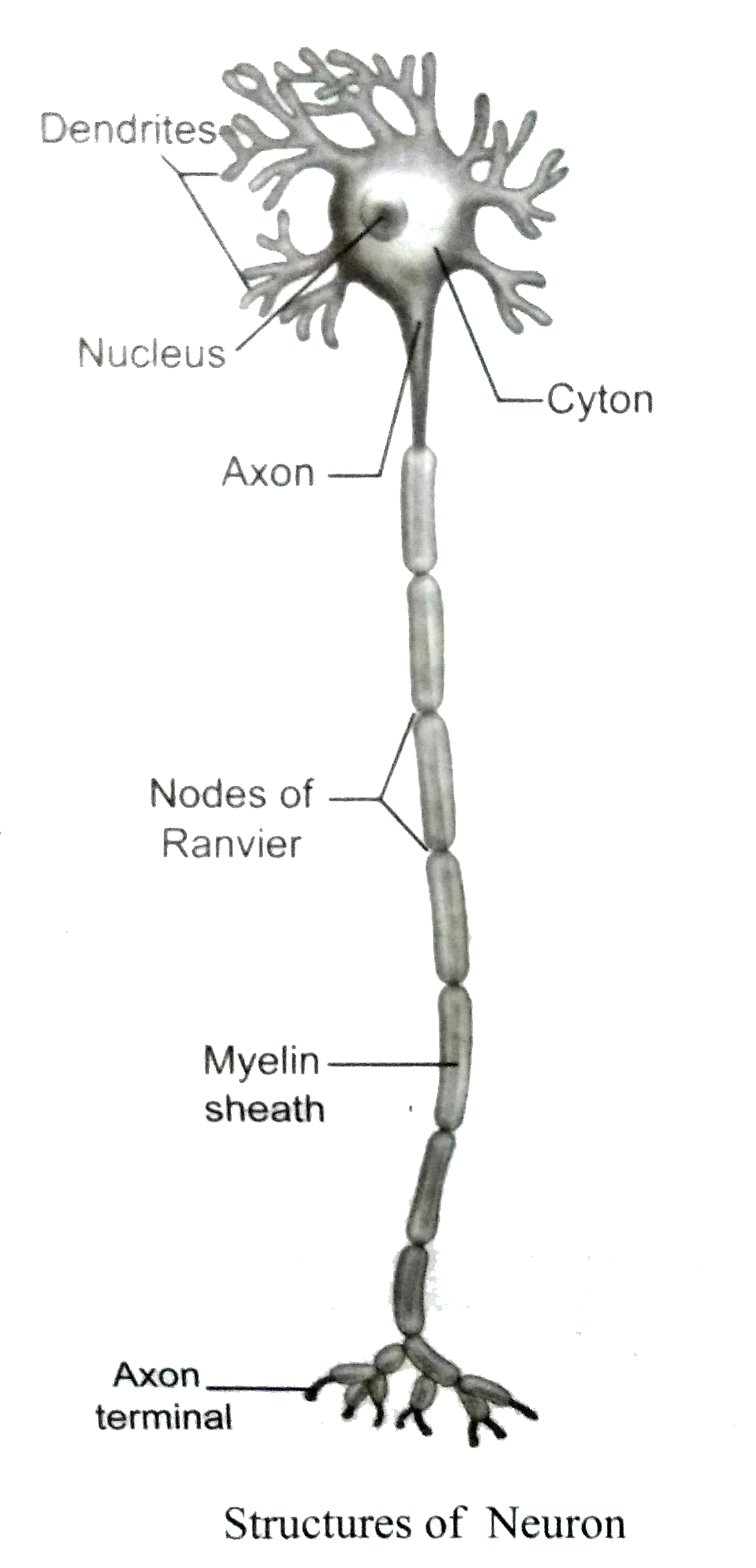Explain the structure of a neuron. Solution in Tamil
Structure of Neuron: A neuron consists of three basic parts namely Cyton, Dendrites and Axon.
(a) Cyton: Cyton is called cell body or perikaryon. It has a central nucleus with abundant cytoplasm called neuroplasm. The cytoplasm has large granular body called Nissl.s granules and the other cell organelles like mitochondria, ribosomes, lysosomes, and endoplasmic reticulum, Neurons do not have the ability to divide. Several neurofibrils are present in the cytoplasm that help in transmission of nerve impulses to and from the cell body.
(b) Dendrites: These are the numerous branched cytoplasmic processes, that object from the surface of the cell body. They conduct nerve impulses, towards the cyton. The branched projections increase the surface area for receiving the signals from other nerve cells.
(c ) Axon: The axon is a single, elongated, slender projections. The end of axon terminates as fine branches, which terminate into knob like swellings called synaptic knob.
The plasma membrane of axon is called axolemma, while the cytoplasm is called axoplasm. It carries impulses away from the cyton. The axons may be covered by a protein sheath called myelin sheath, which is further covered by a layer of Schwann cells called neurilemma. Myelin sheath breaks at intervals, by depressions called Nodes of Ranvier. The region between the nodes is called as internode. Myelin sheath acts as insulator and ensures rapid transmission of nerve impulses.
A junction between synaptic knob of one neuron and dendron of next neuron is called Synaptic Junction. Information from one neuron can pass to another neuron through these junctions, with the release of chemicals known as neurotransmitters, from the synaptic knob.

Topper's Solved these Questions
- NERVOUS SYSTEMBOOK - FULL MARKSCHAPTER - NERVOUS SYSTEMEXERCISE - IX. TEXT BOOK EVALUATION (HOTS).
2 Videos
- NERVOUS SYSTEMBOOK - FULL MARKSCHAPTER - NERVOUS SYSTEMEXERCISE - TEXTBOOK ACTIVITES SOLVED (ACTIVITY)
3 Videos
- NERVOUS SYSTEMBOOK - FULL MARKSCHAPTER - NERVOUS SYSTEMEXERCISE - VII. TEXT BOOK EVALUATION (DIFFERENTIATE BETWEEN)
2 Videos
- HEREDITYBOOK - FULL MARKSCHAPTER - HEREDITYEXERCISE - ADDITIONAL QUESTIONS (HOTS)
2 Videos
- ORIGIN AND EVOLUTION OF LIFEBOOK - FULL MARKSCHAPTER - ORIGIN AND EVOLUTION OF LIFEEXERCISE - Additional Question (VI. Higher Order Thinking skills. [HOTS])
3 Videos
Similar Questions
A' is a cylindrical that begins from the lower end of medulla and extend downwards.It is enclosed in bony cage'B'and covered by membranes 'C'.As many as 'D' pairs of nerves arise from the structure'A'(i)What is A?
(ii)Name (a)bony cage 'B'and (b)membranes 'C'
(iii)How mcuh is D?
View SolutionActivity-1
Create a model of a neuron using clay or beads.
View SolutionVoluntary and involuntary actions.
View SolutionWhat do you understand about DNA, gene and chromosome in short?
View SolutionWhat is the relationship between mutation and variation ?
View SolutionDraw the structure of a neuron and explain its function.
View SolutionDraw the structure of a neuron and explain its function.
View SolutionExplain the structure of neuron with the help of a labelled diagram.
View SolutionExplain the structure of a neuron.
View SolutionWith a neat labelled diagram explain the structure of a neuron.
View SolutionExplain the structure of a multipolar myelinated neuron.
View Solutionन्यूरॉन की संरचना का वर्णन करते हुए इसके विभिन्न कार्य बताइए।
View SolutionDraw the structure of a neuron and explain its function
View SolutionExplain the structure of Neuron with a neatly labelled diagram?
View SolutionDraw the structure of a neuron and explain its function
View SolutionExplain the structure of a neuron.
View Solution
